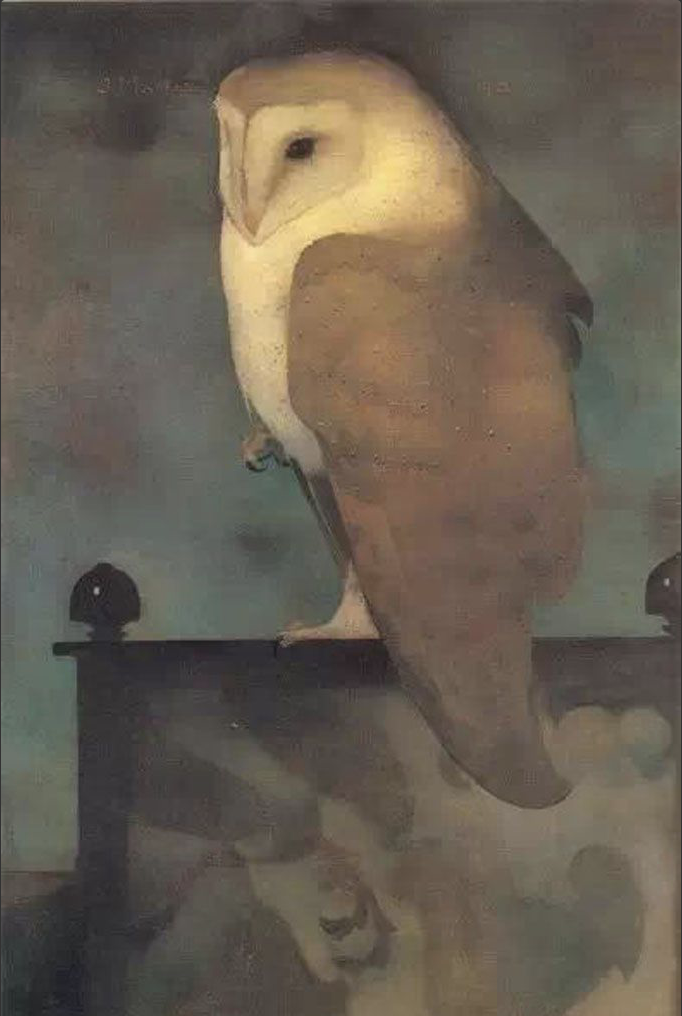A sentiment that questions Piet Mondrian‘s (1872 –1944) status as the master of modernism is, of course, offered in jest. I was just thinking of him when looking at today’s topic, Dutch painter Jan Mankes, (1889 –1920) who lived and worked during Mondrian’s life time, though only for a short 30 years before tuberculosis felled him in 1920.

Some of Manke’s landscapes are of the same subjects, trees, polders, wintry estates, and share some of the same aesthetic. But where Mondrian is intense and penetrating, Manke’s work is some of the most tranquil you’ll find among the modern Dutch masters. It has a porcelain quality, soft brush strokes, and invites lots of introspection. It also allows people into the landscapes.

The quietude, seemingly part of his personality from what I learned from a short biography in a documentary video, (alas not translated into English from the original Dutch, but worth watching for the painting collection on view,) stood in sharp contrast to the personality of his wife: a firebrand.


Anne Zernike (1887 – 1972) who came from a wealthy Amsterdam family of academics and intellectuals (her brother received the Nobel Prize in Physics,) was the first female ordained Protestant minister in the Netherlands. She joined the Mennonites because they were the only ones accepting women in that role. Later, after receiving her doctorate in the same time frame where she had a baby, where her husband died and she needed to move back to the city from their country idyll in Friesland, she attached herself to a more progressive church, the Dutch Protestant Association (NPB.)

Zernike was a pacifist, a radical liberal and staunchly convinced that theology and the arts had to be taught in tandem. After marrying Mankes in 1915, they moved to The Hague where their lives focused on participation in the artistic environment, including literature, painting and poetry; theology, including explorations of Christian Socialism, Taoism and theosophy and vegetarianism. Two years later, in 1917, they relocated to Eerbeek, a small village away from the sea climate which was believed to worsen Manke’s illness. Zernike, while pregnant, wrote her thesis On historical materialism and social democratic ethics there. Beint, their son was born on 1 March 1918 and that same autumn she received her doctorate in divinity from the University of Amsterdam. Jan died about a year and a half later. Here is a similar Dutch video about her life, a sort of docudrama that gives you lovely glimpses of the landscape.)

Mankes was quite successful as an artist during his lifetime, with several collectors supporting his work and sales of both paintings and drawings flourishing. One of his patrons sent him an owl that he frequently painted and kept in the house. Animals fascinated him and he studied them for long periods before painting them from memory. I wonder what would have happened to the odd and intense couple after the five short years granted them in marriage before his death. I wonder if his name would have become known beyond the Dutch borders – he is revered in Holland, but few know of him here.

I think my mother, whose Jahrzeit is this week und who loved owls, would have been a happy camper in that household, sister-in-arms with revolutionary Anne and impressed by the devotion to the winged and other critters present in the studio. Owl photographs in her memory, taken in my very own garden this year.



I am wishing you all a meaningful Thanksgiving, with loneliness converted into feelings of agency: we are all doing our part to get this world back on track until a vaccine is available. I am grateful for the fact that I am in the thoughts of family and friends, as you are in mine, closely held to my heart and in my esteem as warriors in crisis times. I’ll see you back next Monday!
Music is by Elgar, about an owl No. 4 (An Epitath) from the 4 Part Songs, Op. 53 (1907,) dedicated to none other than his pet rabbit! Pietro D’Alba….

